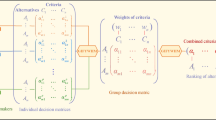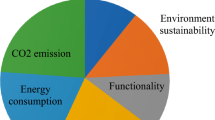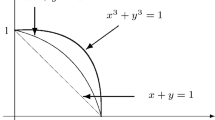Abstract
One of the key issues when it comes to measuring similarity is the discrepancy that exists between the idealized measures and actual human perception. The aim of this paper is to explore the possibility of using logic-based similarity measures for modeling consensus. We propose a soft consensus model for calculating the consensus and proximity degrees on two different levels. The proposed model relies on logic-based similarity measures and the appropriate aggregation functions. It is a fresh approach as it includes logic when perceiving similarity. Several similarity measures based on min, product and Lukasiewicz fuzzy bi-implications are introduced for modeling consensus. We also define a measure of similarity based on interpolative Boolean algebra (IBA) equivalence, and provide its comprehensive theoretical background. In our approach, we analyze how these different logic-based measures treat similarity, and whether they are appropriate to explain the notion of consensus. Finally, we show that IBA equivalence is the only measure that is both appropriate for modeling consensus and interpretable at the same time. The proposed model is illustrated on a problem of project selection in the context of sustainable development and the numerical results are discussed.




Similar content being viewed by others
References
Alonso S, Chiclana F, Herrera F, Herrera-Viedma E, Alcal-Fdez J, Porcel C (2008) A consistency-based procedure to estimate missing pairwise preference values. Int J Intell Syst 23(2):155–175
Baczynski M, Jayaram B (2008) Fuzzy implications. Studies in fuzziness and soft computing 231. Springer, Dordrecht
Beliakov G, Calvo T, James S (2014) Consensus measures constructed from aggregation functions and fuzzy implications. Knowl Based Syst 55:1–8
Bezdek J, Spillman B, Spillman R (1978) A fuzzy relation space for group decision theory. Fuzzy Sets Syst 1(4):255–268
Bosch R (2005) Characterizations of voting rules and consensus measures. Ph.D. Dissertation, Tilburg University
Cabrerizo FJ, Moreno JM, Perez IJ, Herrera-Viedma E (2010) Analyzing consensus approaches in fuzzy group decision making: advantages and drawbacks. Soft Comput 14:451–463
Callejas C, Marcos J, Bedregal BRC (2012) On some subclasses of the Fodor–Roubens fuzzy bi-implication. In: Ong L, De Queiroz R (eds) Logic, language, information and computation, lecture notes in computer science, vol 7456. Springer, Dordrecht, pp 206–215
Chiclana F, Herrera F, Herrera-Viedma E (2001) Multiperson decision making based on multiplicative preference relations. Eur J Oper Res 129:372–385
Chiclana F, Tapia Garcia JM, Del Moral JM, Herrera-Viedma E (2013) A statistical comparative study of different similarity measures of consensus in group decision making. Inf Sci 221:110–123
Deza MM, Deza E (2009) Encyclopedia of distances. Springer, Dordrecht
Di Nola A, Pedrycz W, Sessa S (1988) Fuzzy relation equations with equality and difference composition operators. Fuzzy Sets Syst 25:205–215
Dong YC, Zhang GQ, Hong WC, Xu YF (2010) Consensus models for AHP group decision making under row geometric mean prioritization method. Decis Support Syst 49:281–289
Dragovic I, Turajlic N, Radojevic D, Petrovic B (2014) Combining boolean consistent fuzzy logic and ahp illustrated on the web service selection problem. Int J Comput Intell Syst 7(supp. 1):84–93. doi:10.1080/18756891.2014.853935
Fedrizzi M, Pasi G (2008) Fuzzy logic approaches to consensus modelling in group decision making. In: Ruan D, Hardeman F, Van Der Meer K (eds) Intelligent Decision and Policy Making Support Systems: Studies in Computational Intelligence, vol 117. Springer, Berlin, pp 19–37
Formato F, Gerla G, Scarpati F (1999) Fuzzy subgroups and similarities. Soft Comput 3:1–6
Garcia-Lapresta JL, Perez-Roman D (2011) Measuring Consensus in Weak Orders. In: Herrera-Viedma E, Garcia-Lapresta JL, Kacprzyk J, Fedrizzi M, Nurmi H, Zadrozny S (eds) Consensual Processes: Studies in Fuzziness and Soft Computing 267. Springer, Berlin, pp 213–234
Herrera F, Herrera-Viedma E, Verdegay JL (1996) A model of consensus in group decision making under linguistic assessments. Fuzzy Sets Syst 78:73–87
Herrera-Viedma E, Herrera F, Chiclana F (2002) A consensus model for multiperson decision making with different preference structures. IEEE Trans Syst Man Cybern - Part A: Systems and Humans 32(3):394–402
Herrera-Viedma E, Martinez L, Mata F, Chiclana F (2005) A consensus support system model for group decision-making problems with multigranular linguistic preference relations. IEEE Trans Fuzzy Syst 13(5):644–658
Herrera-Viedma E, Alonso S, Chiclana F, Herrera F (2007) A consensus model for group decision making with incomplete fuzzy preference relations. IEEE Trans Fuzzy Syst 15:863–877
Herrera-Viedma E, Garcia-Lapresta JL, Kacprzyk J, Fedrizzi M, Nurmi H, Zadrozny S (2011) Consensual Processes. Springer, Berlin
Herrera-Viedma E, Cabrerizo FJ, Kacprzyk J, Pedrycz W (2014) A review of soft consensus models in a fuzzy environment. Inf Fus 17:4–13
Janowicz K, Raubal M, Kuhn W (2011) The semantics of similarity in geographic information retrieval. J Sp Inf Sci 2:29–57
Kacprzyk J, Fedrizzi M (1988) A soft measure of consensus in the setting of partial (fuzzy) prefe-rences. Eur J Oper Res 34:316–323
Kacprzyk J, Zadrozny S, Fedrizzi M, Nurmi H (2007) On group decision making, consensus reaching, voting and voting paradoxes under fuzzy preferences and a fuzzy majority: A survey and some perspectives. In: Bustince H, Herrera H, Montero J (eds) Fuzzy Sets and Their Extensions: Representation. Aggregation and Models, Springer, Berlin, pp 263–295
Khorshid S (2010) Soft consensus model based on coincidence between positive and negative ideal degrees of agreement under a group decision-making fuzzy environment. Expert Syst Appl 37:3977–3985
Klawonn F, Castro JL (1995) Similarity in Fuzzy Reasoning. Mathw Soft Comput 2:197–228
Klement EP, Mesiar R, Pap E (2002) Triangular norms. Kluwer Academic Publishers, Dordrecht
Le Capitaine H (2012) A relevance-based learning model of fuzzy similarity measures. IEEE Trans Fuzzy Syst 20(1):57–68
Li P, Jin Q (2012) Fuzzy relational equations with min-biimplication composition. Fuzzy Optim Decis Mak 11(2):227–240
Lu J, Zhang G, Ruan D (2008) Intelligent multi-criteria fuzzy group decision-making for situation assessments. Soft Comput 12:289–299
Lukka P, Leppalampi T (2006) Similarity classifier with generalized mean applied to medical data. Comput Biol Med 36(9):1026–1040
Luukka P (2011) Feature selection using fuzzy entropy measures with similarity classifier. Expert Syst Appl 38(4):4600–4607
Mata F, Martinez L, Herrera-Viedma E (2009) An adaptive consensus support model for group decision making problems in a multi-granular fuzzy linguistic context. IEEE Trans Fuzzy Syst 17(2):279–290
Milosevic P, Poledica A, Dragovic I, Radojevic D, Petrovic B (2013) Logic-based similarity measures for consensus. In: Mladenovic N, Savic G, Kuzmanovic M, Makajic-Nikolic D, Stanojevic M (eds) Proceedings of XI Balkan conference on operational research (BALCOR 2013). Newpress, Smederevo, pp 473–481
Milosevic P, Petrovic B, Radojevic D, Kovacevic D (2014) A software tool for uncertainty modeling using interpolative Boolean algebra. Knowl Based Syst 62:1–10
Montero J (2008) The impact of fuzziness in social choice paradoxes. Soft Comput 12:177–182
Moser B (2006) On representing and generating kernels by fuzzy equivalence relations. J Mach Learn Res 7:2603–2620
Niittymakia J, Turunen E (2003) Traffic signal control on similarity logic reasoning. Fuzzy Sets Syst 133:109–131
Palomares I, Liu J, Xu Y, Martinez L (2012) Modelling experts’ attitudes in group decision making. Soft Comput 16:1755–1766
Poledica A, Milosevic P, Dragovic I, Radojevic D, Petrovic B (2013) A consensus model in group decision making based on interpolative boolean algebra. In: Pasi G, Montero J, Ciucci D (eds) Proceedings of the 8th conference of the European Society for Fuzzy Logic and Technology (EUSFLAT-13). doi:10.2991/eusflat.2013.98
Radojevic D (2000) New [0, 1]-valued logic: a natural generalization of Boolean logic. Yugosl J Oper Res 10(2):185–216
Radojevic D (2008) Logical aggregation based on interpolative Boolean algebra. Mathw Soft Comput 15:125–141
Radojevic D (2010) Generalized (real-valued) order and equivalence relations. In: Forca B, Kovac M, Cabarkapa O, Petrovic D (eds) Proceedings of the 37th symposium on operational research (SYM-OP-IS 2010). Medija centar Odbrana, Belgrade, pp 451–454
Rissland EL (2006) Ai and similarity. IEEE Intell Syst 21(3):39–49. doi:10.1109/mis.2006.38
Spillman B, Bezdek J, Spillman R (1979) Coalition analysis with fuzzy sets. Kybern 8:203–211
Tapia Garcia JM, Del Moral MJ, Martinez MA, Herrera-Viedma E (2012) A consensus model for group decision making problems with linguistic in-terval fuzzy preference relations. Expert Syst Appl 39:10022–10030
Tversky A (1977) Features of similarity. Psychol Rev 84(4):327–352
Wang WJ (1997) New similarity measures on fuzzy sets and on elements. Fuzzy Sets Syst 85(3):305–309
Wu Z, Xu J (2012) Consensus reaching models of linguistic preference relations based on distance functions. Soft Comput 16:577–589
Xu ZS (2005) An approach to group decision making based on incomplete linguistic preference relations. Int J Inf Technol Decis Mak 4(1):153–160
Author information
Authors and Affiliations
Corresponding author
Additional information
Communicated by V. Loia.
Rights and permissions
About this article
Cite this article
Poledica, A., Milošević, P., Dragović, I. et al. Modeling consensus using logic-based similarity measures. Soft Comput 19, 3209–3219 (2015). https://doi.org/10.1007/s00500-014-1476-5
Published:
Issue Date:
DOI: https://doi.org/10.1007/s00500-014-1476-5




